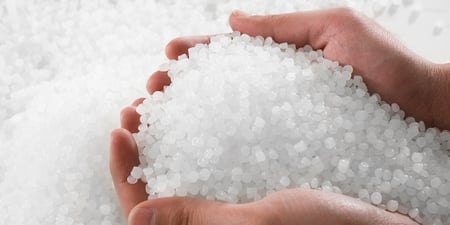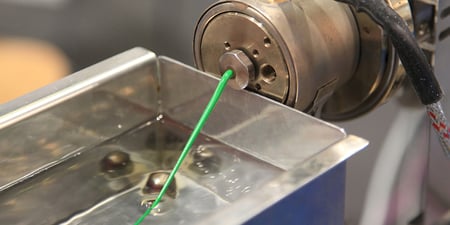
Generally, we talk about 2 main types of purge compound: Mechanical Purging Compounds and Chemical Purging Compounds. Mechanical grades are ideal for quick and easy color changes on the fly, as they work by increasing pressure in the barrel. These types of compound can often have a one-size-fits-all solution if dealing with a commodity resin type, especially in injection molding applications where you can easily increase pressure in the barrel.
Chemical Purging Compounds, on the other hand, work by heat and containment. This allows them to work extremely well in low pressure and low flow environments (which are often hard to reach and clean). For best results they require a soak time, and the purge selection in these cases can also be more stringent. With that criteria in mind, they are often the best choice for hot runners and for extrusion. Whichever route you choose, investing the time to select the right purge and follow the right instructions will be extremely beneficial in the long run. At this time, I am working with 2 different film processors on identifying a solution to reduce their scrap rates.
Although in each case the problem is the same – our purge recommendation will vary based on their specific processing conditions and resin. Many companies (including both of these processors) have had a negative experience with a purge compound in the past. You may be in the same boat! In my experience, this is usually because of 2 things: 1.) using the incorrect purge and/or 2.) following the incorrect method. Having a purge consult before you proceed is key, as purging does NOT always have a one size fits all solution. Just like your process will have specific parameters in place to achieve the end product you desire; purge selection is very much the same. Incorrect use or assuming one purge works for all situations will all but guarantee you see less impressive results. Set yourself up for success and follow the instructions.
Below were my recommendations to each customer:
Company #1: Sheet Extrusion – Common Grade Recommendations are NCR or NCT (depending on M.I of resin)
For this HDPE Sheet Extruder, resin changes and machine shutdowns were minimal, but color changes were leading to hours, sometimes day of streaking. They had 1 co-extruder consisting of 3 lines, 2 x 2.5” screws and 1 x 3.5” diameter screw. With an extruder of this size, scrap rates are no joke. The HDPE in this case had a very low Melt Index (range from 0.2-0.5MI) so the chemical purge selected was NCT. A pre-flush was recommended (keep in mind the resin chosen to flush must be stiffer than the incumbent resin). Heats were increased by 100F across the entire system and the barrel was filled with the NCT purge compound at regular speed. As soon as purge is seen exiting the die, we reduced speeds to the minimum RPM. The purge was allowed to soak for 15 minutes, after the initial soak there was some streaking still observed, which appeared to be at the die. We increased the heats at the die by a further 50F, re-filled the machine with clean purge and followed with an additional 15 minutes soak, after this soak the purge appeared completely clean and they were able to proceed into the next color with over 80% reduction in resin scrap.
Company #2: Blown Film Extrusion – Recommendation NCF, or UF2
This blown film manufacturer was processing LDPE and at start-up they were seeing over 5000lbs in scrap- due to black specks that have occurred after oxidation in the barrel. In this case, the best fit for cleaning out the LDPE was our NCF Grade purge. A similar purging procedure was followed (as above) this time after the 1st soak was complete, the machine was re-filled with clean purge and then heats were turned off for the shutdown. The purge is safe to seal the machine during any length of shutdown (hours, days, weeks) as long as heats are turned off. At start-up the processor was able to go straight into production with a 76% reduction in scrap.
Both processors had a very different experience with purge this time. Always see reach out to a purge consultant to find out which purge is recommended for your process and resin.
Ready to reduce your production downtime to protect your profits? Learn more about how purging compounds and process efficiency work in tandem.

Kiran Raza is an Asaclean Purging Expert & Technical Sales Representative. She's worked in the plastics industry for nearly 20 years and has expertise In Bio-Medical Materials, Polymer Processing, and Materials Testing.







Comments